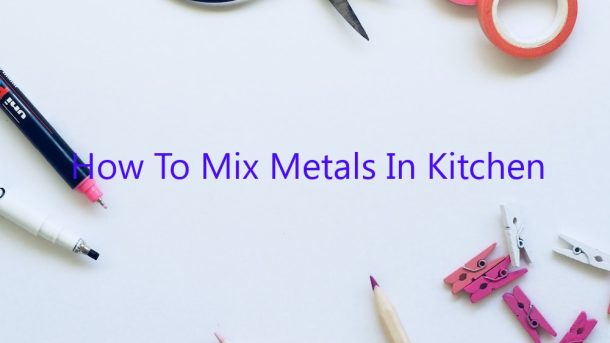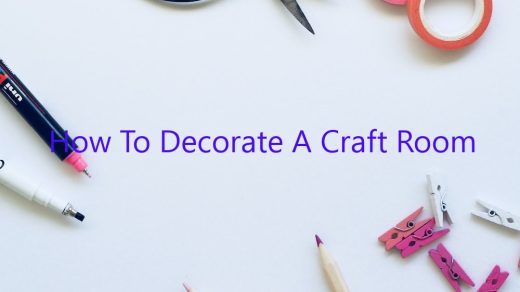The kitchen is a place where many homeowners like to add their own personal touch. One way to do this is by mixing metals in the kitchen. This can be a fun and creative way to add some personality to your kitchen, and it can also be a way to add some functionality and style.
When it comes to mixing metals in the kitchen, there are a few things to keep in mind. The first is that you want to make sure that all of the metals are compatible. In other words, you don’t want to mix metals that will create a reaction.
The second thing to keep in mind is the tone of the metals. You want to make sure that all of the metals have the same tone, or they will clash.
If you want to mix metals in the kitchen, here are a few tips to help you get started:
1. Choose metals that are compatible.
2. Make sure all of the metals have the same tone.
3. Use metals that are complementary, not competing.
4. Make sure the metals are in good condition and are polished.
5. Use a small amount of metal, and mix it with other materials.
6. experiment with different metals and combinations.
When it comes to mixing metals in the kitchen, there are no hard and fast rules. You can experiment with different metals and combinations to see what works best for you. Just make sure to keep the above tips in mind, and you should be able to create a beautiful and functional kitchen that reflects your personal style.
Contents
How do you mix and match metals in a kitchen?
Mixing metals in a kitchen can be a fun way to add some personality and style to your cooking area. However, it’s important to know which metals to mix and how to do it properly to avoid any potential problems.
One of the most important things to remember when mixing metals in a kitchen is to avoid using two metals that are of different colors. For example, pairing silver and gold kitchen hardware can look beautiful, but if you have a stainless steel refrigerator, it will clash horribly.
It’s also important to be aware of the different properties of different metals. For example, copper is a soft metal that can be easily scratched, so it’s not the best choice for hardware that will be used frequently. In contrast, stainless steel is a hard metal that is less likely to scratch.
When mixing metals in a kitchen, it’s important to use metals that have similar properties. For example, you can mix different types of stainless steel, brass, or bronze together without any problems. However, it’s not a good idea to mix copper and stainless steel together, as the copper will quickly corrode the stainless steel.
If you’re not sure which metals to mix together, it’s always best to consult with a professional. They will be able to help you choose the right metals and give you some tips on how to mix them together for a beautiful and functional kitchen.
Can you mix different metals in a kitchen?
Can you mix different metals in a kitchen?
In a word, no. Different metals have different properties and can react with each other in dangerous ways.
For example, if you mix aluminum and copper in a kitchen, the aluminum will corrode and create a toxic gas. If you mix steel and aluminum, the aluminum will corrode and create a flammable gas.
If you’re not sure whether two metals will react with each other, it’s best to avoid mixing them in the kitchen.
How do you mix metals at home?
Metals are mixed at home by either melting them together or combining them in a chemical reaction. In both cases, the goal is to create alloys, which are mixtures of two or more metals.
To create an alloy by melting metals together, you need a crucible, tongs, and a heat source. The crucible is a container made of heat-resistant material, such as clay, graphite, or porcelain, that can withstand the high temperatures required to melt metals. The tongs are used to hold the crucible, and the heat source can be a furnace, stovetop, or Bunsen burner.
To create an alloy by combining metals in a chemical reaction, you need a container and a chemical reaction kit. The container can be any type of container that is made of non-reactive material, such as glass or plastic. The chemical reaction kit contains all the chemicals needed to create a reaction between two or more metals.
In either case, the first step is to identify the metals that will be used to create the alloy. The metals can be in the form of pure metals, alloys, or compounds. Next, determine the amounts of each metal that will be used in the alloy. This can be done by weight or volume.
If melting the metals together, the crucible is filled with the desired amount of metal and heated until the metal is melted. The molten metal is then poured into a mold to create the desired shape. If combining the metals in a chemical reaction, the metal compounds are mixed together in the container and the reaction is allowed to take place. The alloy will form in the container and can be collected when the reaction is complete.
The physical and chemical properties of alloys vary depending on the metals that are used to create them. Alloys usually have higher melting points and densities than the pure metals they are made of. They also have different colors, depending on the metals that are used. For example, an alloy of copper and tin is bronze, while an alloy of iron and carbon is steel.
Is it OK to mix brass and stainless steel?
Stainless steel and brass are both alloys that are made up of different metals. Brass is a mix of copper and zinc, while stainless steel is a mix of iron, chromium, and nickel.
There are a few reasons why you might want to mix brass and stainless steel. One reason might be if you are trying to create a specific alloy. Another reason might be if you are trying to make a cheaper metal look more expensive.
Brass is a softer metal than stainless steel. This means that it can be scratched or dented more easily. It can also be more prone to corrosion than stainless steel.
Stainless steel is more durable than brass. It is less likely to corrode or rust, and it is less likely to be scratched or dented.
If you are planning to mix brass and stainless steel, it is important to consider the different properties of each metal. You will need to decide which metal is more important to you and choose the appropriate alloy.
Is rubbed bronze out of style?
Is rubbed bronze out of style? That seems to be the question on many people’s minds lately. So, let’s take a look at the pros and cons of this trend to see if it’s time to say goodbye to rubbed bronze.
On the plus side, rubbed bronze can give a space a warm, antique feel. It can also be a more subtle way to add metallic accents to a room than, say, gold or silver.
However, there are some potential drawbacks to using rubbed bronze. For one, it can be quite expensive, especially if you’re using it on a large scale. It can also be difficult to keep rubbed bronze looking its best; it can quickly become scratched or dented.
In the end, it’s up to you whether or not you want to go with rubbed bronze. If you’re drawn to the look and feel of this trend, go for it! But if you’re not sure if it’s right for you, it might be best to wait and see if it becomes more popular in the coming years.
What metal finishes go together?
What metal finishes go together?
This is a question that comes up a lot in the world of design. Different metal finishes can look great together, or they can clash horribly. So, what are the best combinations?
One of the most popular combinations is silver and gold. Silver has a cool, metallic look, while gold has a warmer, more golden hue. They look great together and can be used in a variety of settings.
Another popular combination is black and brass. Black has a modern look, while brass has a more classic feel. These two finishes also look great together.
If you’re looking for something a little more adventurous, you could try combining copper and bronze. These two metals have very different colors, but they can be complementary if used in the right way.
The best way to figure out what metal finishes go together is to experiment. Try different combinations and see what looks best to you. Keep in mind the tone of the room and the other finishes that are already present. With a little experimentation, you’ll be able to create beautiful combinations that will complement your overall design scheme.
Can you mix copper and stainless steel in a kitchen?
Mixing copper and stainless steel in a kitchen is not recommended. While the two metals may look similar, they have different properties that can cause problems when they are mixed.
Copper is a soft metal that is prone to scratches and dents. Stainless steel is a hard metal that is resistant to scratches and dents. If these two metals are mixed, the softer copper will be more prone to damage.
Copper also has a higher thermal conductivity than stainless steel. This means that it can transfer heat more quickly than stainless steel. If these two metals are mixed, the copper will transfer heat more quickly, which can cause the stainless steel to warp or melt.
In addition, copper can cause stainless steel to corrode. If these two metals are mixed, the copper will corrode the stainless steel, which can cause damage to the kitchen.
For these reasons, it is not recommended to mix copper and stainless steel in a kitchen. If you do decide to mix the two metals, be sure to take precautions to avoid damage to your kitchen.




